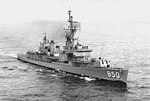Patrol torpedo boat PT-617
1945 shipsBuildings and structures in Fall River, MassachusettsMuseum ships in MassachusettsNational Historic Landmarks in MassachusettsNational Register of Historic Places in Fall River, Massachusetts ... and 3 more
PT boatsShips on the National Register of Historic Places in MassachusettsWorld War II on the National Register of Historic Places

Motor torpedo boat PT-617, also known as Big Red Cock and Dragon Lady, "is the sole surviving 80' Elco type PT boat and represents the United States's most heavily used, highly favored, and combat-tested PT boat type in World War II." She is a museum ship at the PT Boat Museum in Fall River, Massachusetts. The 80-foot (24 m) Elco type boat was the predominant type and is the same type as the famous PT-109 commanded by John F. Kennedy; the 78-foot (24 m) "Higgins" boat is the other type. PT-617 was declared a National Historic Landmark in 1989.
Excerpt from the Wikipedia article Patrol torpedo boat PT-617 (License: CC BY-SA 3.0, Authors, Images).Patrol torpedo boat PT-617
Battleship Cove Drive, Fall River
Geographical coordinates (GPS) Address Nearby Places Show on map
Geographical coordinates (GPS)
| Latitude | Longitude |
|---|---|
| N 41.705277777778 ° | E -71.163333333333 ° |
Address
State Pier
Battleship Cove Drive
02722 Fall River
Massachusetts, United States
Open on Google Maps











